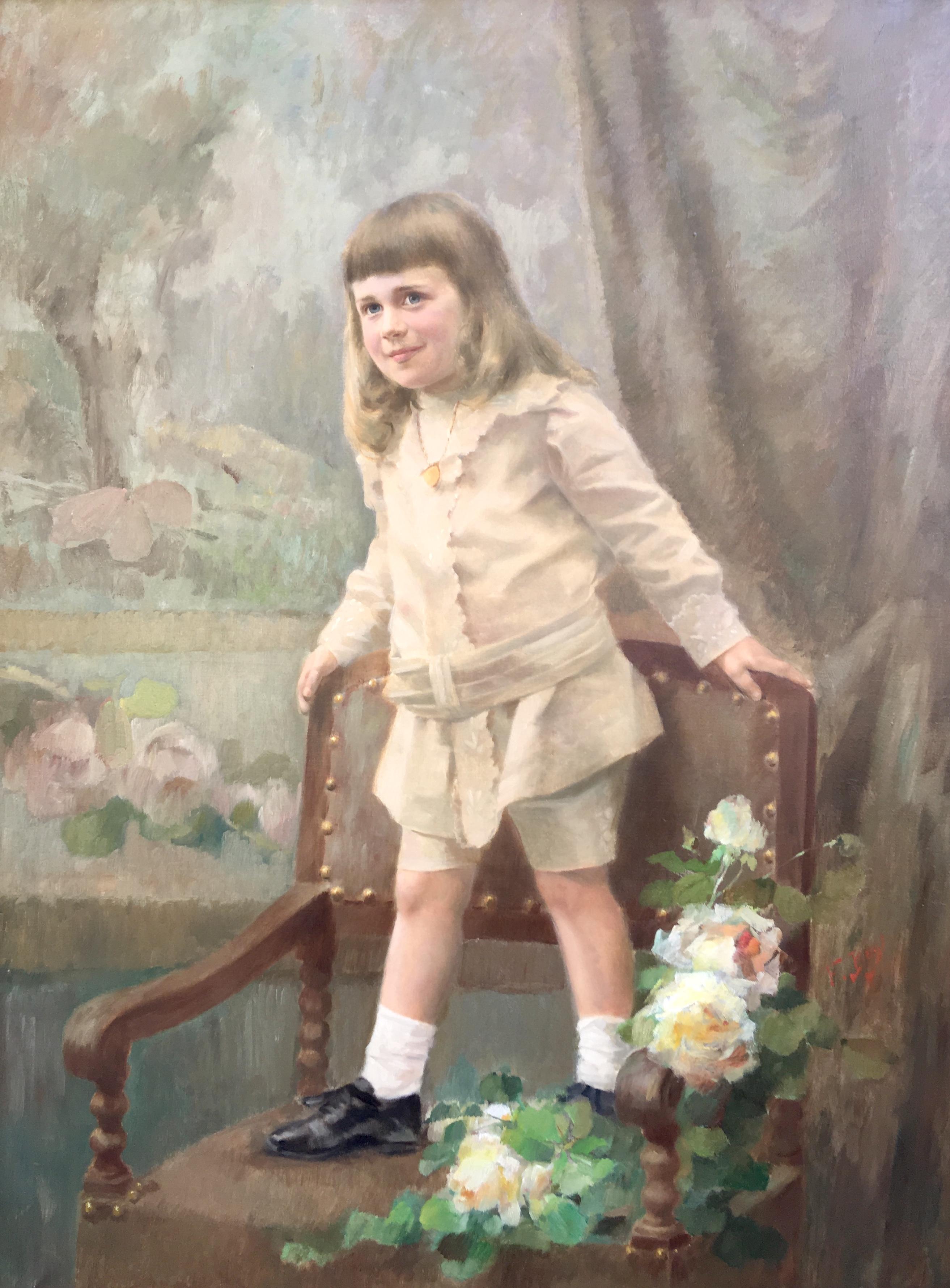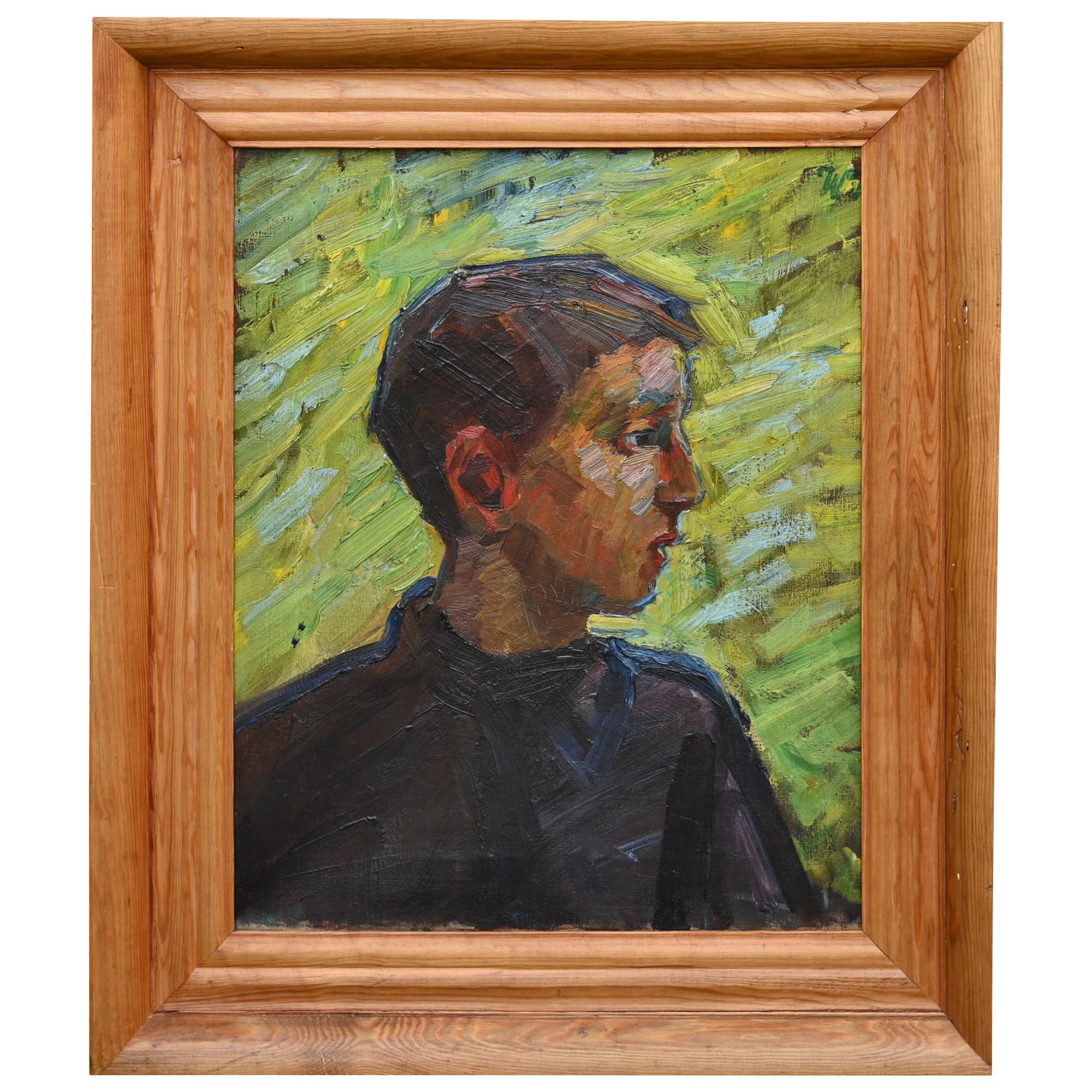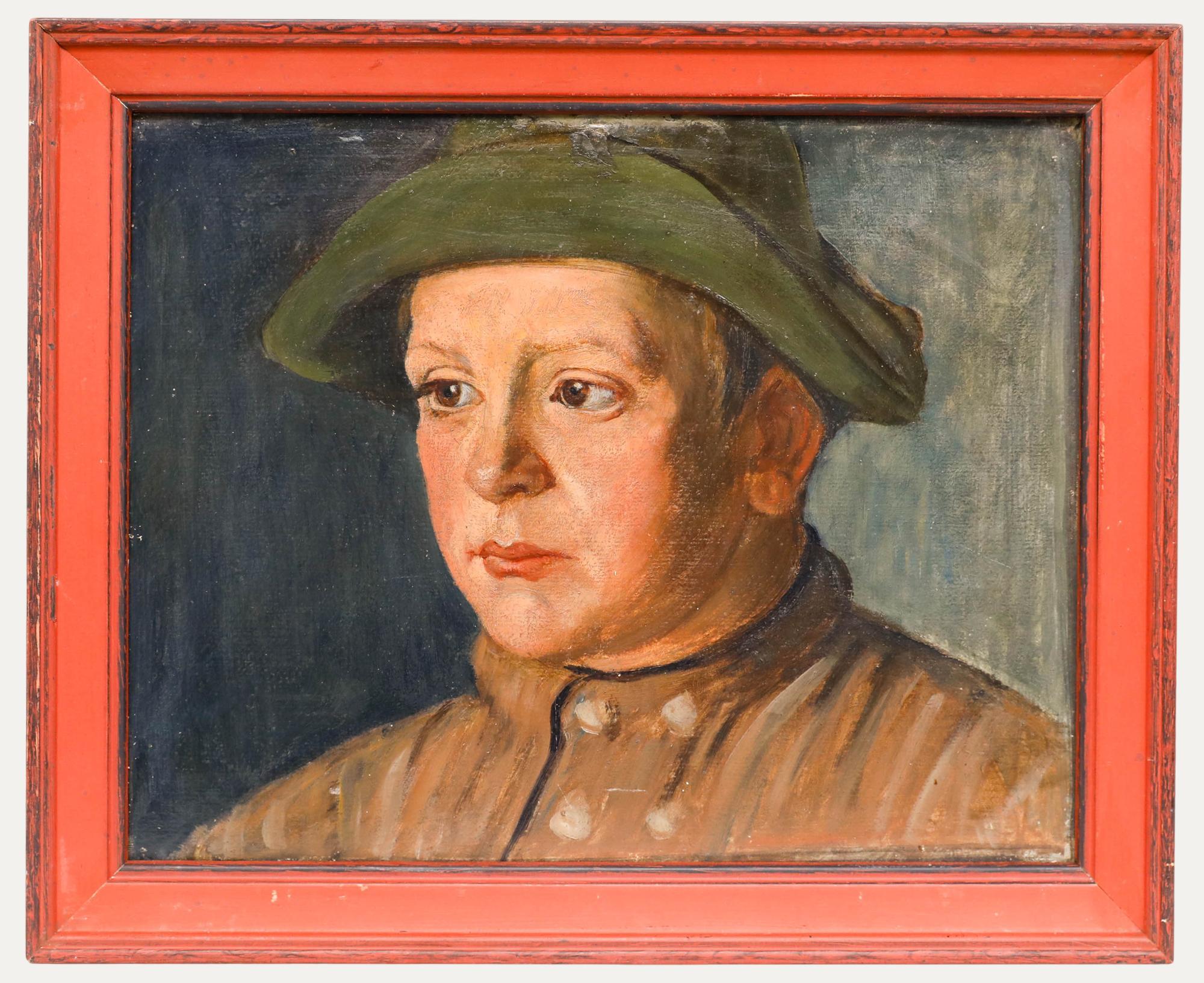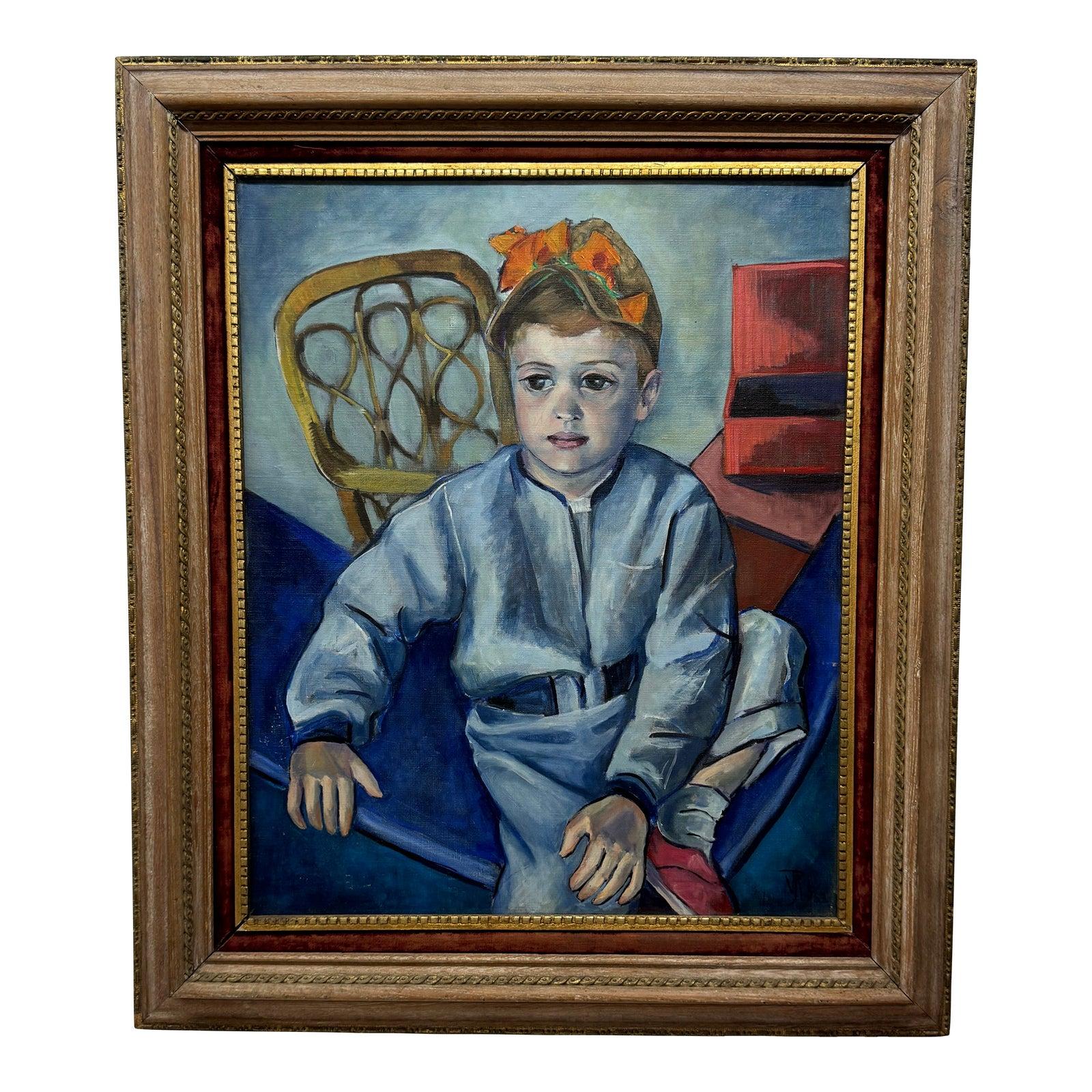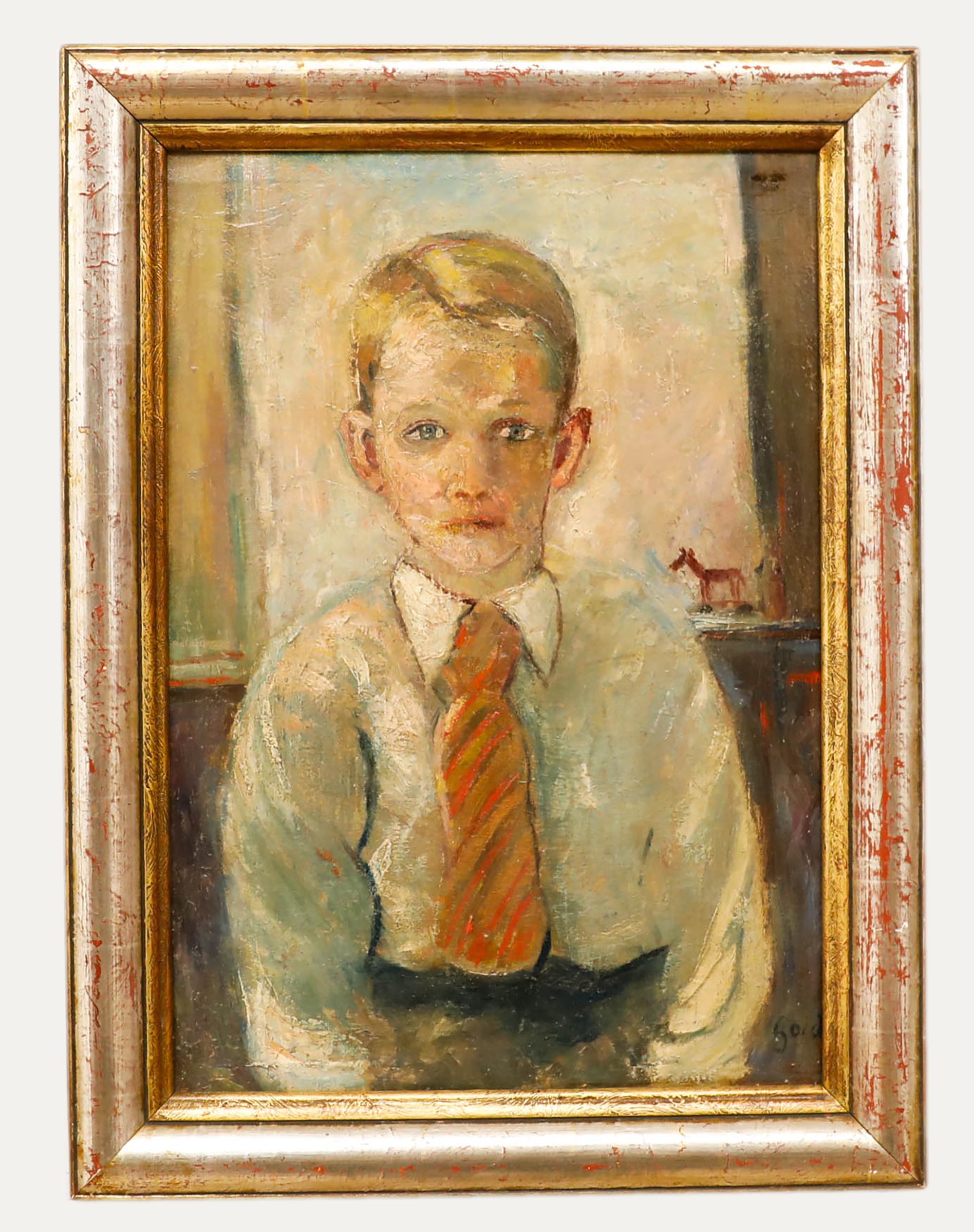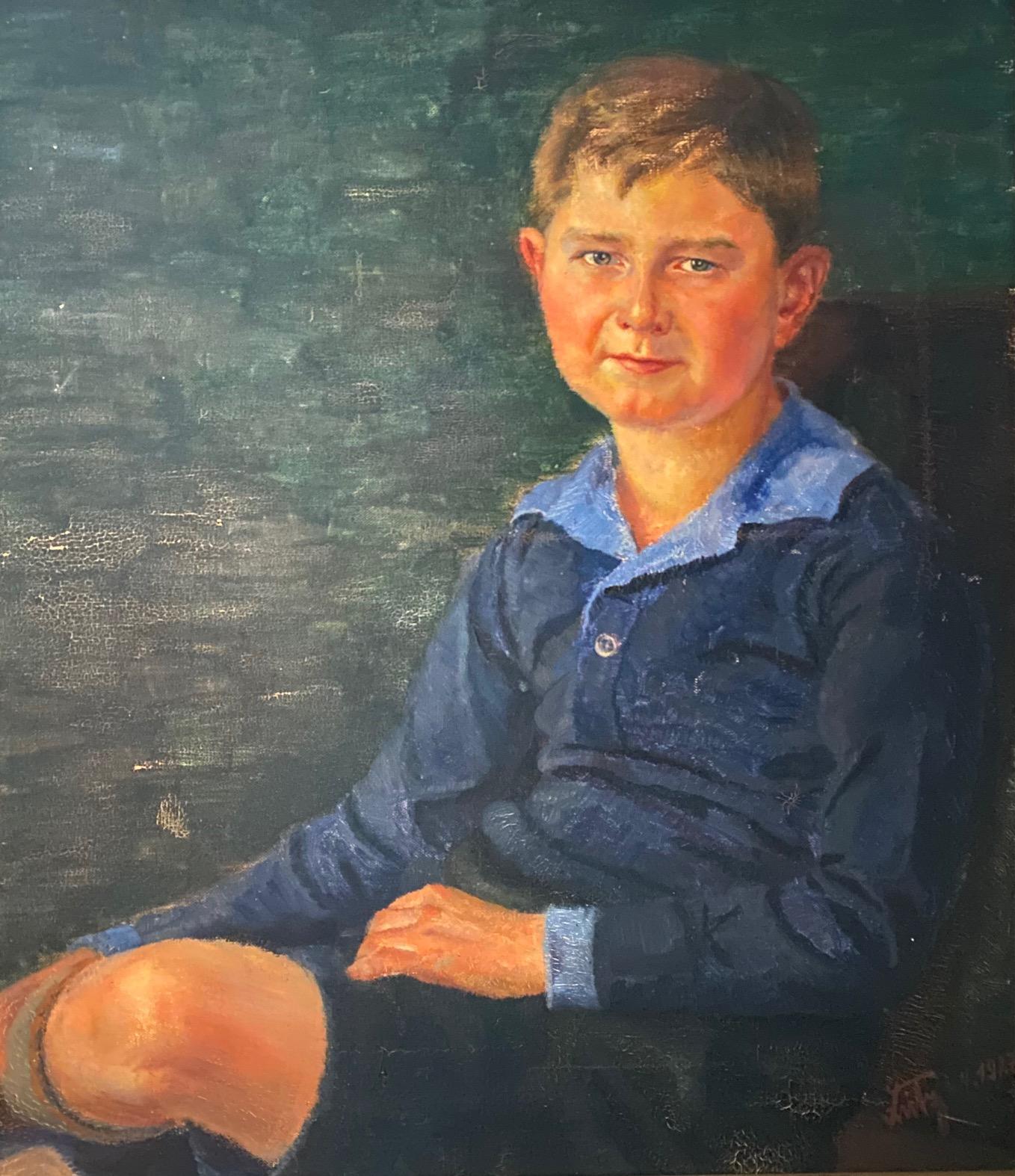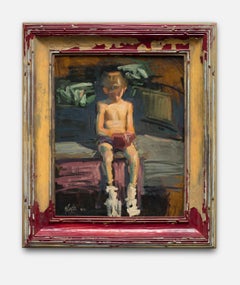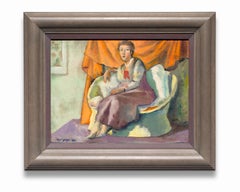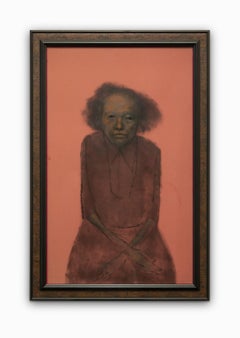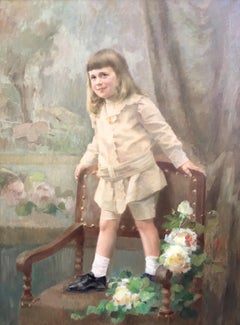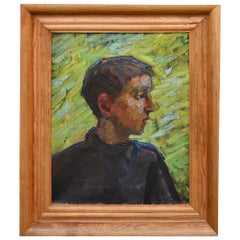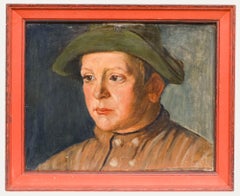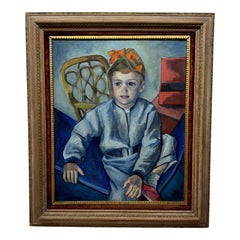Items Similar to "Portrait of a Young Eero Saarinen", Painted By His Father Eliel Saarinen, Oil
Want more images or videos?
Request additional images or videos from the seller
1 of 11
Eliel Saarinen"Portrait of a Young Eero Saarinen", Painted By His Father Eliel Saarinen, Oilc. 1917
c. 1917
Price Upon Request
Price Upon Request
Price Upon Request
Price Upon Request
Price Upon Request
Price Upon Request
Price Upon Request
Price Upon Request
Price Upon Request
Price Upon Request
About the Item
This portrait of a precocious young boy is significant for two reason: the subject is Eero Saarinen, the famed designer of tulip chairs and architect best known for designing the Washington Dulles International Airport outside Washington, D.C., the TWA Flight Center in New York City, and the Gateway Arch in St. Louis, Missouri, and the painter is his father Eliel Saarinen, the Finnish-American architect who designed the Helsinki Central railway station, the National Museum of Finland, the Vyborg railway station, the Hvitträsk, and the Kleinhans Music Hall in Finland and the famous Cranbrook Academy campus, where he would then go on to teach at the Cranbrook Academy of Art and become its president in 1932. It's provenance is Eero Saarinen's own son, the award-winning cinematographer Eric Saarinen. The painting is Painting is 23.25 x 16.25.
Eliel Saarinen was born in 1873 in Rantasalmi, Finland. was educated in Helsinki at the Helsinki University of Technology. From 1896 to 1905 he worked as a partner with Herman Gesellius and Armas Lindgren at the firm Gesellius, Lindgren, Saarinen. His first major work was showcased at the Finnish pavilion at the 1900 World Fair in Paris. His early style was known as Finnish National Romanticism. After moving to the United States he designed the Gulf Building in Houston and became a visiting professor at the University of Michigan. In 1925 he was requested to design the Cranbrook campus. His work has been exhibited in many prestigious places, such as his iconic tea urn at the Metropolitan Museum of Art in New York, the St. Louis Art Museum, Cranbrook Art Museum, the British Museum in London, and the Metropolitan Museum of Art. The touring exhibition Modernism in American Silver: 20th-Century Design, organized by the Dallas Museum of Art, which also traveled to the Smithsonian Institution in Washington, DC. the British Museum in London and the Metropolitan Museum of Art also hold tea urn-related Eliel Saarinen designs.
Eero Saarinen was born in 1910. He grew up in Bloomfield Hills, Michigan and took courses in sculpture and furniture design at the Cranbrook Academy of Art. He had a close relationship with fellow students Charles and Ray Eames, and became good friends with Florence Knoll (née Schust). He began his studies in sculpture at the Académie de la Grande Chaumière in Paris, France, in September 1929. He then went on to study at the Yale School of Architecture, completing his studies in 1934. In 1940 he designed his famous Tulip chairs and in 1948 he designed what would be his most well-known sculpture, the Gateway Arch in St. Louis. His Crow Island School in Winnetka, Illinois would also achieve international acclaim while the first major work by Saarinen, in collaboration with his father, was the General Motors Technical Center in Warren, Michigan, which follows the rationalist design Miesian style, incorporating steel and glass but with the addition of accent of panels in two shades of blue.
After his father's death in July 1950, Saarinen founded his own architect's office, Eero Saarinen and Associates. He was the principal partner from 1950 until his death. The firm carried out many of its most important works, including the Bell Labs Holmdel Complex in Holmdel Township, New Jersey; Gateway Arch National Park (including the Gateway Arch) in St. Louis, Missouri; the Miller House in Columbus, Indiana; the TWA Flight Center at John F. Kennedy International Airport, which he worked on with Charles J. Parise; the main terminal of Washington Dulles International Airport; and the new East Air Terminal of the old Athens airport in Greece, which opened in 1967. Many of these projects use catenary curves in their structural designs.
Eero Saarinen was elected a Fellow of the American Institute of Architects in 1952. He was elected a member of the National Institute of Arts and Letters in 1954. In 1962, he was posthumously awarded a gold medal by the American Institute of Architects. In 1940, he received two first prizes together with Charles Eames in the furniture design competition of the Museum of Modern Art in New York City. In 1948, he won the first prize in the Jefferson National Monument competition. The Boston Arts festival in 1953 gave him their Grand Architectural Award. He received the First Honor award of the American Institute of Architects twice, in 1955 and 1956, and their gold medal in 1962. In 1965 he took first prize in US Embassy competition in London
- Creator:Eliel Saarinen
- Creation Year:c. 1917
- Dimensions:Height: 29.25 in (74.3 cm)Width: 22.5 in (57.15 cm)
- Medium:
- Period:
- Condition:
- Gallery Location:Detroit, MI
- Reference Number:1stDibs: LU128616998592
About the Seller
5.0
Vetted Professional Seller
Every seller passes strict standards for authenticity and reliability
Established in 2014
1stDibs seller since 2019
108 sales on 1stDibs
Typical response time: 14 hours
- ShippingRetrieving quote...Shipping from: Detroit, MI
- Return Policy
Authenticity Guarantee
In the unlikely event there’s an issue with an item’s authenticity, contact us within 1 year for a full refund. DetailsMoney-Back Guarantee
If your item is not as described, is damaged in transit, or does not arrive, contact us within 7 days for a full refund. Details24-Hour Cancellation
You have a 24-hour grace period in which to reconsider your purchase, with no questions asked.Vetted Professional Sellers
Our world-class sellers must adhere to strict standards for service and quality, maintaining the integrity of our listings.Price-Match Guarantee
If you find that a seller listed the same item for a lower price elsewhere, we’ll match it.Trusted Global Delivery
Our best-in-class carrier network provides specialized shipping options worldwide, including custom delivery.More From This Seller
View AllMarvin Cherney Portrait "Seated Girl" Oil on Canvas
By Marvin Cherney
Located in Detroit, MI
SALE ONE WEEK ONLY
"Seated Girl" is an oil on canvas portrait of an artist who was cut down in his prime and largely forgotten until recently. Marvin Cherney's paintings are solemn but unsophisticated in his subjects. He deploys a more limited range of greyed colors in order to emotionalize his subject and heighten the mood of their isolation. This painting was one of the thirteen that was exhibited at Garelick's Gallery in Detroit from January 8th through January 21st in 1961. The painting is 34.75 x 22.5 inches unframed.
Marvin Cherney was born in Baltimore, Maryland in 1925. He attended the Maryland Institute of Art and the School for Art Studies in New York. After his graduation he began to travel around Europe before returnig to New York.
Cherney won 2 Tiffany Awards and Brooklyn Museum Prize and his work has been exhibited at the National Academy of Design, The Art Institute of Chicago, Brooklyn Museum, Audubon Artists, University of Nebraska, Silvermine Artists Guild, Butler Art Institute, Ringling Museum, Howard University...
Category
1950s Portrait Paintings
Materials
Canvas, Oil
"Untitled" Small Male Child, Dressed for Boxing, Nostalgic, Antiqued Frame
Located in Detroit, MI
SALE ONE WEEK ONLY
Steve Huston worked construction to support himself through college. That experience seems to have heightened his aesthetic interest i...
Category
Early 2000s Contemporary Figurative Paintings
Materials
Canvas, Oil
Edgar Yeager Figurative Interior Scene
By Edgar Yaeger
Located in Detroit, MI
SALE ONE WEEK ONLY
Yaeger was an American Modernist painter from Detroit, Michigan, who is credited with being one of the first painters in this style. The portrait “Untitled” easil...
Category
1980s American Modern Figurative Paintings
Materials
Canvas, Oil
Fantastic Rafael Coronel Mixed Media 1961
By Rafael Coronel
Located in Detroit, MI
"Untitled" is a dramatically placed individual who appears to be withdrawing into herself surrounded by a soft pinkish color. She has a sad look in her non-reflective eyes. This pain...
Category
Mid-20th Century Futurist Portrait Paintings
Materials
Mixed Media, Board, ABS
Fanny Rabel Figurative Oil Painting Soulful, Prayerful
By Fanny Rabel
Located in Detroit, MI
SALE ONE WEEK ONLY
UNTITLED by Fanny Rabel a Mexican artist who was born in Poland in 1922 is a soul wrenching work depicting among other things, the children killed by Nazi bombing in Spain during the Second World War. The lavender and purple surrounding the seated female figure and the kneeling child suggest both grief for the innocents' deaths and the prayers being offered for an end to the carnage. The bright gold and red can be read as either explosions or the hopeful light of redemption after death. Like Picasso's Guernica from 1937, this painting from 1965 can stand as a powerful anti-war statement.
Numerous key galleries and museums such as Morton Auctions, Cerro de Mayka have featured Fanny Rabel's work in the past. Her anti-Nazi and anti-Fascism politics resulted in her participation in a mural called Retrato de la Burguesía in 1940 for the Sindicato Mexicano de Electricistas building on Alfonso Caso Street in Mexico City. Rabel met a group of exiled Spaniards in Mexico along with Antonio Pujol, who invited her to take part in a mural project headed by him, David Alfaro Siqueiros, Joseph Renau, Luis Arenal, Antonio Rodríguez Luna and Miguel Prieto. The artist died in 2008.
Fanny Rabel born August 27, 1922, in Poland born Fanny Rabinovich, was a Polish-born Mexican artist who is considered to be the first modern female muralist and one of the youngest associated with the Mexican muralism of the early to the mid-20th century. She and her family arrived in Mexico in 1938 from Europe and she studied art at the Escuela Nacional de Pintura, Escultura y Grabado "La Esmeralda", where she met and became friends with Frida Kahlo. She became the only female member of “Los Fridos” a group of students under Kahlo’s tutelage. She also worked as an assistant and apprentice to Diego Rivera and David Alfaro Siqueiros, painting several murals of her own during her career. The most significant of these is "Ronda en el tiempo" at the Museo Nacional de Antropología in Mexico City. She also created canvases and other works, with children often featured in her work, and was one of the first of her generation to work with ecological themes in a series of works begun in 1979.
She is considered to be the first female muralist in Mexico. She was an assistant to Diego Rivera while he worked on the frescos for the National Palace and an apprentice to David Alfaro Siqueiros. Her most important mural is Ronda en el tiempo located in the Museo Nacional de Antropología, which was created from 1964 to 1965. She also created murals at the Unidad de Lavaderos Público de Tepalcatitlán (1945), Sobrevivencia, Alfabetización in Coyoacán in 1952 Sobrevivencia de un pueblo at the Centro Deportivo Israelita (1957) Hacia la salud for the Hospital Infantil de México (1982), La familia mexicana at the Registro Público de la Propiedad (1984) (which Rabel preferred to title Abolición de la propiedad privada) and at the Imprenta Artgraf. In collaboration with other artists, she participated in the creation of the murals at the La Rosita pulque bar (disappeared) and at the Casa de la Madre Soltera.
She entered the Escuela Nacional de Pintura, Escultura y Grabado "La Esmeralda" shortly after it was established in 1942, taking classes with José Chávez Morado, Feliciano Peña and Frida Kahlo, with whom she became close friends. She changed her last name from Rabinovich to Rabel during her career.
Rabel married urologist Jaime Woolrich and had two children Abel and Paloma Woolrich, both of whom became actors. The first exhibition of her work was in 1945 with twenty-four oils, thirteen drawings, and eight engravings at the Liga Popular Israelita with Frida Kahlo writing the presentation. In 1955, she had an individual exhibition at the Salón de la Plástica Mexicana. She had a large exhibition at the Museum of the Palacio de Bellas Artes to commemorate a half-century of her work. Her last exhibition was in 2007 at the Universidad Autónoma Metropolitana. Her work can be found in collections in over fifteen countries including those of the New York Public Library, the Library of Congress in Washington, D.C., the Royal Academy of Denmark, the National Library in Paris, the Casa de las Américas in Havana, the Benemérita Universidad Autónoma de Puebla and the Museo de Arte Moderno in Mexico City.
A retrospective of her work after her death called Retrospectiva in Memoriam, Fanny Rabel (1922-2008) was held at the Museum of the Universidad Popular Autónoma del Estado de Puebla . She is considered to be the first modern female muralist in Mexico although she also did significant work in painting, engraving, drawing, and ceramic sculpture. Her work has been classified as poetic Surrealism, Neo-expressionism and is also considered part of the Escuela Mexicana de Pintura (the dominant art movement of the early to mid 20th century in Mexico) as one of the youngest muralists to be associated with it along with Arnold Belkin and José Hernández Delga.
Rabel was more drawn to depicting mankind’s pain rather than happiness, sharing other Mexican muralists' concerns about social injustice. However, she stated to Leopoldo Méndez that she could not create combative works, with clenched fists and fierce faces, and she wanted to leave the Taller de Gráfica Popular. Méndez convinced her to stay, saying that more tender images are important to political struggle as well. Children with Mexican faces...
Category
1960s Expressionist Figurative Paintings
Materials
Oil, Canvas
Charles Pompilius figurative Young Female Nude Oil on Panel
Located in Detroit, MI
"Untitled" portrays a young female nude in an intimate setting within the artist's studio. This painting is done in the classical vein of full portraiture. The model, however, is not posed quietly, but is engaged with a person or object off the frame, or, perhaps in an interior monologue with herself. Regardless of which, the viewer's attention is not only attracted to the beauty of the model's figure, but the intention of her actions.
Charles Pompilius...
Category
Early 2000s American Modern Figurative Paintings
Materials
Oil, Panel
You May Also Like
Portrait of Young Boy, Oil on Canvas Signed Felix Bryk, circa 1910
Located in Paris, FR
Lovely portrait of a young Boy standing on an armchair.
Oil on canvas signed Felix BRYK.
Swedish School, circa 1900-1910
Portraitist and ethnologist of the early twentieth century.
...
Category
1910s Academic Portrait Paintings
Materials
Canvas
$5,706 Sale Price
20% Off
Portrait of a Boy , German about 1910, oil on Canvas signed W.T.
Located in Epfach, DE
Portrait of a boy, German , oil on Canvas ,
with nice colors and green and blue in the back
signed W.T.
Category
Vintage 1910s German Paintings
Materials
Canvas
Carl Baum (1892-1966) - 1936 Oil, Portrait of Reinhard Vogel
Located in Corsham, GB
A striking early 20th century study by the artist Carl Baum (1892-1966) depicting a young soldier. The artist has sensitively captured the subject's poignant expression, prompting th...
Category
Early 20th Century Portrait Paintings
Materials
Oil
Portrait Painting of Young Boy
By Virginia Sevier Rogers
Located in San Francisco, CA
Portrait painting of young boy by California listed artist Virginia Sevier Rogers
1952
Oil on Canvas
Signed and dated lower right
22" W x 27" H unframed, 30" W x 35" H framed
Category
Mid-20th Century Modern Portrait Paintings
Materials
Oil
Anton Gold (1914-1970) - Mid 20th Century Oil, The Schoolboy
Located in Corsham, GB
This evocative portrait captures a young boy in school uniform, with a striking orange tie contrasting against his pale shirt and background. The loose, impressionistic brushwork cre...
Category
20th Century Portrait Paintings
Materials
Oil
Young boy by Hannes Fritz-München - Oil on canvas 64x73 cm
Located in Geneva, CH
Oil on canvas sold with frame
Total size with frame 78x87 cm
Hannes FRITZ-MÜNCHEN is an artist born in 1886 and died in 1981
Category
1920s Realist Portrait Paintings
Materials
Oil
$1,400 Sale Price
20% Off
More Ways To Browse
Painted Hall Chair
Kennedy Chair
Charles Of London Chair
Crow Sculpture
John F Kennedy Furniture
Grand Tour Urn
Saarinen Cranbrook Chairs
Tulip Office Chair
Antique Music Chair
Antique Tea Urn
Grand Central Station
John Kennedy Sculpture
Yale Chair
Silver Tea Urn
Grand Central Terminal
Eames 1956
Old Paris Urn
Antique Boston Chair
